Back to Product Category
TUFLEX
EYE AND EYE ROUNDSLINGS |
|
|
|
|
 |
|
| A
More Rugged and Durable Tuflex |
|
|
|
|
|
|
|
| The
Eye and Eye Advantage |
|
|
|
|
|
|
|
An
additional jacket of texturized, abrasion resistant
nylon covers the body of the standard Tuflex,
forming two color coded lifting eyes. |
|
|
|
|
|
|
|
| Maintains
all the basic Tuflex features plus... |
|
|
|
|
|
|
|
 Saves money by extending sling life where Saves money by extending sling life where
abrasion to sling body is a problem. |
|
|
|
|
|
|
|
 |
|
|
|
|
|
|
|
 |
|
Order
Online, by Phone, or by E-Mail |
|
|
|
~ Add
items to your online shopping cart ~
Click a Price of the item you wish to purchase. |
|
|
|
|
*Constact
Us For Special Lengths* |
|
|
Part
No. |
Color
of
Eyes |
Rated Capacity (lbs.)‡ |
Min.
Length
(ft.)+ |
Approximate Measurements |
Ext'd. prices @ lgths shown (ft.) |
| Vertical |
Choker |
Basket |
Wgt.
(lbs./ft.) |
Body
Width
at Load
(W)
(in.) |
Std Eye
Length
(EL)
(in.) |
Min.
Hardware
Dia.
(in.)** |
3' |
4' |
6' |
8' |
| EE30 |
Purple |
|
2,600 |
2,100 |
5,200 |
4 |
0.25 |
2 1/4 |
10 |
1/2 |
*NA |
|
|
|
| EE60 |
Green |
|
5,300 |
4,200 |
10,600 |
4 |
0.36 |
2 1/2 |
10 |
5/8 |
|
|
|
|
| EE90 |
Yellow |
|
8,400 |
6,700 |
16,800 |
4 |
0.5 |
2 1/2 |
12 |
3/4 |
|
|
|
|
| EE120 |
Tan |
|
10,600 |
8,500 |
21,200 |
5 |
0.6 |
3 1/2 |
12 |
7/8 |
|
|
|
|
| EE150 |
Red |
|
13,200 |
10,600 |
26,400 |
5 |
0.84 |
3 1/2 |
14 |
1 |
|
|
|
|
| EE180 |
White |
|
16,800 |
13,400 |
33,600 |
7 |
0.96 |
3 1/2 |
16 |
1 1/8 |
|
|
|
|
| EE240 |
Blue |
|
21,200 |
17,000 |
42,400 |
7 |
1.5 |
4 1/4 |
16 |
1 1/4 |
|
|
|
|
| EE360 |
Grey |
|
31,000 |
24,800 |
62,000 |
7 |
1.8 |
6 |
20 |
1 1/2 |
*NA |
|
|
|
| EE600 |
Brown |
|
53,000 |
42,400 |
106,000 |
8 |
2.7 |
7 |
24 |
1 7/8 |
*NA |
*NA |
*NA |
|
| EE800 |
Olive |
|
66,000 |
52,800 |
132,000 |
10 |
3.3 |
8 |
30 |
2 1/8 |
*NA |
*NA |
|
|
| EE1000 |
Black |
|
90,000 |
72,000 |
180,000 |
12 |
4.2 |
9 |
36 |
2 1/2 |
*NA |
*NA |
*NA |
|
|
|
|
|
|
*NA - Quoted upon request. |
| ‡ |
 |
|
Always
protect roundslings from corners, edges, or protrusions. Refer to the Sling
Protection section
below to choose the right protection product for your lift. |
|
|
|
|
|
|
|
|
|
|
|
|
|
**This
is the minimum recommended diameter for the connection hardware to be used
for a vertical hitch. |
|
|
|
|
+
Shorter lengths available using reduced eye lengths. |
|
|
|
THE
TUFLEX DIFFERENCE |
|
|
|
|
All Lift-All
slings meet or exceed OSHA and ASME B30.9 standards and regulations. |
|
|
|
|
| What
is a Tuflex Roundsling? |
•
Extremely flexible, conforms to shape of load to
grip securely.
• Tubular jacket protects load bearing yarns from
UV degradation.
• Red core yarns provide added visual warning of
sling damage.
• Color-coding provides positive sling capacity
information. |
|
|
|
It
is an synthetic sling made from a skein (continuous loop
or hank) of polyester yarn covered by a double wall
tubular jacket. The roundsling body can also be compared
to sling webbing with the tubular jacket face yarns woven
without binder yarns; this allows the core yarns to move
independently within the jacket. |
|
|
|
| Tufhide™
Jacket on EN360 and Larger Slings |
|
|
|
Saves
Money
• Double-wall cover for greater sling life.
• The soft cover will not scratch the load surface.
• Conforms to shape of the load for reduced load
damage.
• The cover is seamless with no sewn edges,
preventing rupture which requires removal from
service.
• EN360 and larger Tuflex roundslings feature Tufhide
wear-resistant nylon jacket for extra sling life.
• Tuff-Tag provides required OSHA information for the
life of the sling. |
|
|
|
Made
from bulked nylon fibers, the double wall Tufhide
jacket offers better abrasion resistance for our larger
capacity Tuflex (EN360 and larger). In addition, Tufhide
reduces the heat buildup that can damage other high
capacity roundslings when used in a choker hitch. |
|
|
|
Tuflex Roundslings
Features, Advantages and Benefits |
|
|
|
| Promotes
Safety |
|
•
Light weight reduces fatigue and strain on riggers
• Synthetic materials won’t cut hands
• Consistent matched lengths for better multiple sling load
control
• No loss of strength from abrasion to cover
• Tuff-Tag provides serial numbered identification for
traceability
• Low stretch (about 3% at rated capacity)
• Synthetic web resists marring of the load.
• Good for low headroom lifts. |
|
|
|
Saves
Time
• Color-coded capacities for quick identification.
• Lightweight and pliable for easy rigging and storage.
• Independent core yarns choke tightly but release
easily after use.
• Easy to store and carry. |
|
|
|
|
|
Sling
Protection |
|
CUT
AND WEAR PROTECTION |
|
|
|
|
|
| Selection
of Sling Protection Products |
|
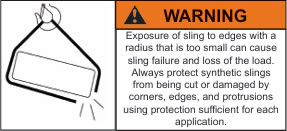 |
|
Sling
protection products need to be used in applications where sling
damage may occur. Cutting of synthetic slings during use is the number
one cause of sling accidents. A variety of factors influence sling
protection performance. Since no material is fully cut proof, a qualified
person must select materials and methods that adequately protect
slings from edges or surfaces. We can assist customers with their
product selections. |
|
|
|
|
|
|
|
| Cut
Protection versus Wear Protection |
|
|
Our
sling protection products are divided into two categories, Cut Protection
and Wear Protection. Cut Protection
Products are designed to improve workplace safety. When placed between slings
and edges, cut protection products
act as a buffer to prevent sling cutting and to reduce bearing pressure
levels at contact areas. Wear protection
products serve to extend sling life by reducing abrasive wear and prevent
marring of the load surfaces.
The following table provides comparative sling protection performance for
standard products. |
|
|
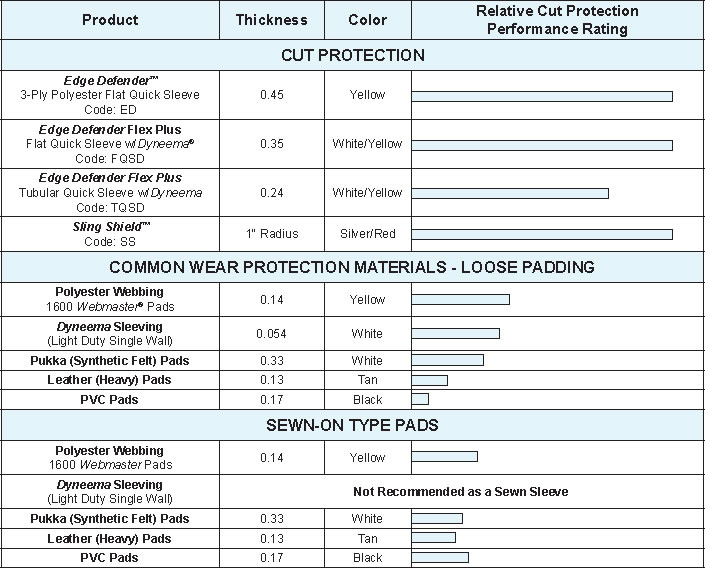 |
Performance
Rating: The bar graphs shown above reflect the comparative performance
of Our Cut Protection
products against commonly used loose and sewn-on types of Wear Protection
products.
Test Lift Qualification: To validate the suitability of sling protection
products for each application, always
complete one or more test lifts in a non-consequence manner.
Technical Bulletin MS-10 available for additional information. |
|
|
|
|
|
|
|
|
|
|
| EFFECT
OF SLING ANGLE |
|
|
|
|
|
|
|
|
|
Using
slings at an angle can become deadly if that angle is not taken into
consideration when selecting the sling to
be used. The tension on each leg of the sling is increased as the angle
of lift, from horizontal, decreases. It is most
desirable for a sling to have a larger angle of lift, approaching 90°.
Lifts with angles of less than 30° from horizontal
are not recommended. If you can measure the angle of lift or the length
and height of the sling as rigged, you can
determine the properly rated sling for your lift. The Increased Tension
method provides the increased tension as a
function of the sling angle. Alternatively, the sling Reduced Capacity method
may be used to determine reduced lift
capacity for any angle. |
|
|
|
|
|
|
|
|
|
INCREASED
TENSION
Determine capacity
of sling needed |
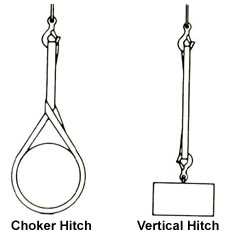 |
REDUCED
CAPACITY
Calculate rating of each sling
rigged at this angle |
|
|
|
|
|
| 1.
Determine the load weight (LW). |
1.
Calculate the reduction factor (RF). |
|
|
|
|
a.
Using the angle from horizontal,
read across the Angle Chart to
the corresponding number of the
Reduction Factor column. |
| 2.
Calculate the Tension Factor [TF]. |
|
|
a.
Determine the sling angle as mea-
sured from the horizontal, and the
corresponding tension factor (TF)
from the effect of angle chart. |
|
|
|
-OR- |
|
|
b.
Divide sling height* (H) by sling
length* (L). |
|
-OR- |
|
|
|
b.
Length* (L) divided by height*
(H) |
|
|
|
|
|
2.
Reduction factor (RF) x the sling’s
rated capacity for the type hitch that
will be used = sling’s reduced rating. |
|
|
|
|
|
|
|
|
|
|
|
|
3.
Determine the share of the load
applied to each sling leg (LW). |
|
|
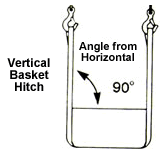 |
|
|
|
|
|
|
|
|
|
|
|
|
|
|
4.
Multiply (LW) by (TF) to determine
the sling leg tension. The capacity of
the selected sling or sling leg must
meet the calculated tension value. |
|
|
*Measured
from a common horizontal
plane to the hoisting hook. |
|
|
|
|
|
|
|
|
|
|
|
|
*Measured
from a common horizontal plane
to the hoisting hook. |
|
|
|
|
|
|
|
|
|
|
|
|
|
|
|
|
 |
|
Effect
of Angle Chart |
|
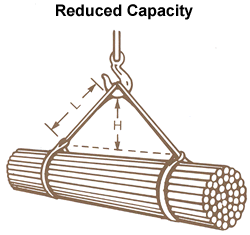 |
|
|
Tension
Factor (TF) |
Angle From
Horizontal |
Reduction
Factor (RF) |
| 1.000 |
90º |
1.000 |
| 1.004 |
85º |
0.996 |
| 1.015 |
80º |
0.985 |
| 1.035 |
75º |
0.966 |
| 1.064 |
70º |
0.940 |
| 1.104 |
65º |
0.906 |
| 1.155 |
60º |
0.866 |
| 1.221 |
55º |
0.819 |
| 1.305 |
50º |
0.766 |
| 1.414 |
45º |
0.707 |
| 1.555 |
40º |
0.643 |
| 1.742 |
35º |
0.574 |
| 2.000 |
30º |
0.500 |
|
|
|
|
|
|
|
|
|
Example: |
|
|
|
Vertical
Choker rating of each sling:
6,000 lbs.
Measured Length (L) = 6 ft.
Measured Height (H) = 4 ft.
Reduction Factor (RF) = 4 (H) ÷ 6 (L) = .667 |
|
|
|
|
| Example: |
|
|
|
Load
weight = 1,000 lbs.
Rigging - 2 slings in vertical hitch
Lifting Weight (LW) per sling = 500 lbs.
Measured Length (L) = 10 ft.
Measured Height (H) = 5 ft.
Tension Factor (TF) = 10 (L) ÷ 5 (H) = 2.0
Minimum Vertical Rated Capacity required
for this lift = 500 (LW) x 2.0 (TF) = 1000 lbs.
per sling |
|
Sling
capacity decreases as the angle
from horizontal decreases. Sling angles
of less than 30° are not recommended. |
|
|
Reduced
sling rating in this configuration
= .667 |
|
(RF)
x 6,000 lbs. = 4,000 lbs. of lifting
capacity per sling |
|
|
|
|
|
|
|
Polyester Roundslings, Single
Part Endless, Lifting Slings, Lift-All, Polyester Sling, Eye and Eye,
Braided Roundslings,
Tuflex, and Large Capacity Slings from your source for material handling
equipment. |
Back to Product Category
|



